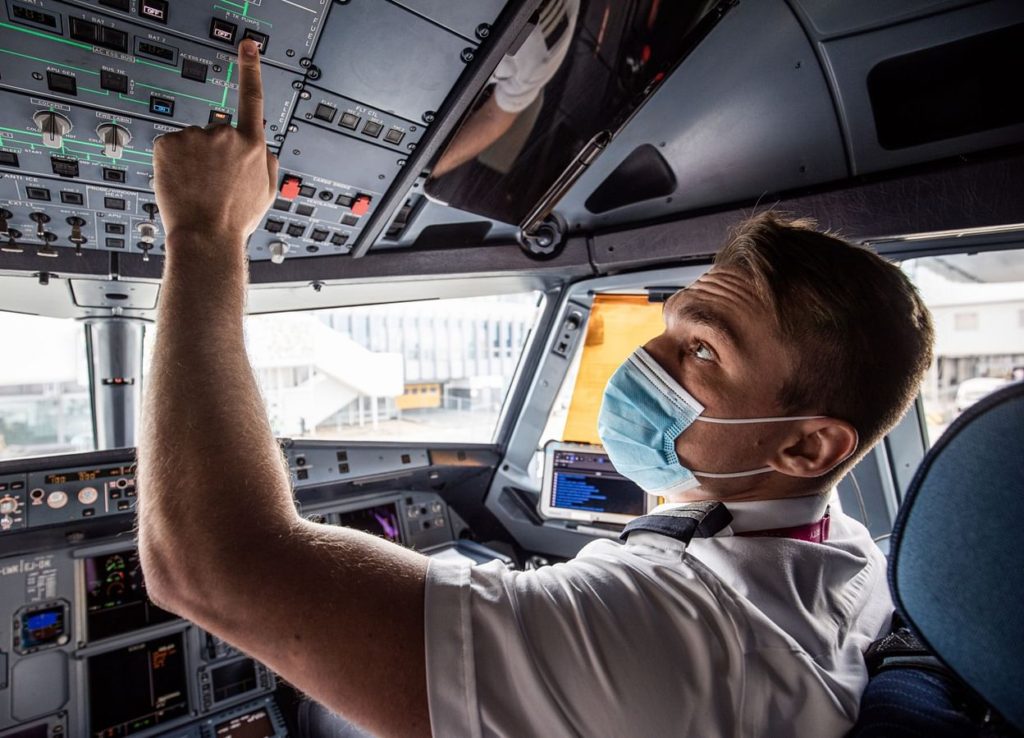Pilot Aptitude Battery Test

Pilot Aptitude Battery Test is an aptitude test designed and conducted for all those candidates who aspire and apply for a flying career in the Air Force. The main aim is to test the mental alertness, presence of mind and self-confidence of the candidate. It checks whether a prospective candidate has proper control over his nerves while he is flying an aircraft. For this, the candidate is put through tests including meter reading, flying test and drum test. You can take the test only once.
You can download a 10 days Trial Version Navigation simulator from the website: http://www.luizmonteiro.com/
METER READING TEST / INSB : In this test the candidate is given 5 questions to be answered in 12Minutes. After this there is a second set of 60 questions on two Meters (Horizon and compass) for which 20 minutes are given to answer them. This test is designed to see whether a candidate has the ability to read meters quickly so as to enable him to adjust his flight with the help of these meter readings.
Know More About The Instruments :

Altimeter

The altimeter shows the aircraft’s altitude above sea-level by measuring the difference between the pressure in a stack of aneroid capsules inside the altimeter and the atmospheric pressure obtained through the static system. It is adjustable for local barometric pressure which must be set correctly to obtain accurate altitude readings. As the aircraft ascends, the capsules expand and the static pressure drops, causing the altimeter to indicate a higher altitude. The opposite effect occurs when descending. With the advancement in aviation and increased altitude ceiling the altimeter dial had to be altered for use both at higher and lower altitudes . Hence when the needles were indicating lower altitudes i.e. the first 360 degree operation of the pointers was delineated by the appearance of a small window with oblique lines warning the pilot that he is nearer to the ground. This modification was introduced in the early sixties after the recurrence of air accidents caused by the confusion in the pilot’s mind. At higher altitudes the window will dis-appear.
Attitude indicator
The attitude indicator (also known as an artificial horizon) shows the aircraft’s relation to the horizon. From this the pilot can tell whether the wings are level and if the aircraft nose is pointing above or below the horizon. This is a primary instrument for instrument flight and is also useful in conditions of poor visibility. Pilots are trained to use other instruments in combination should this instrument or its power fail.
Airspeed indicator
The airspeed indicator shows the aircraft’s speed (usually in knots ) relative to the surrounding air. It works by measuring the ram-air pressure in the aircraft’s pitot tube. The indicated airspeed must be corrected for air density (which varies with altitude, temperature and humidity) in order to obtain the true airspeed, and for wind conditions in order to obtain the speed over the ground.
Magnetic compass
The compass shows the aircraft’s heading relative to magnetic north. While reliable in steady level flight it can give confusing indications when turning, climbing, descending, or accelerating due to the inclination of the Earth’s magnetic field. For this reason, the heading indicator is also used for aircraft operation. For purposes of navigation it may be necessary to correct the direction indicated (which points to a magnetic pole) in order to obtain direction of true north or south (which points to the Earth’s axis of rotation).
Heading indicator
The heading indicator (also known as the directional gyro, or DG; sometimes also called the gyrocompass, though usually not in aviation applications) displays the aircraft’s heading with respect to magnetic north. Principle of operation is a spinning gyroscope, and is therefore subject to drift errors (called precesion) which must be periodically corrected by calibrating the instrument to the magnetic compass. In many advanced aircraft (including almost all jet aircraft), the heading indicator is replaced by a Horizontal Situation Indicator (HSI) which provides the same heading information, but also assists with navigation.
Vertical speed indicator
The VSI (also sometimes called a variometer, or rate of climb indicator) senses changing air pressure, and displays that information to the pilot as a rate of climb or descent in feet per minute, meters per second or knots.
Additional panel instruments that may not be found in smaller aircraft
Course deviation indicator
The CDI is an avionics instrument used in aircraft navigation to determine an aircraft’s lateral position in relation to a track, which can be provided by a VOR or an Instrument Landing System.
This instrument can also be integrated with the heading indicator in a horizontal situation indicator.
Radio Magnetic Indicator
An RMI is generally coupled to an automatic direction finder (ADF), which provides bearing for a tuned Non-directional beacon (NDB). While simple ADF displays may have only one needle, a typical RMI has two, coupled to different ADF receivers, allowing for position fixing using one instrument.
LIGHT CONTROL TEST:
The entire apparatus is installed in a room. The ground glass screen
is in the front and a stool fixed in the center of the room. There
are number of gears along both the sides of the stool. There are
mechanical gadgets to control and direct the flights.
- This has two aims. Firstly, it is meant to test a candidate’s aptitude for flying an aircraft and controlling it during the flight, so that it follows a correct route in the air and keeps correct balance which is very essential during flight. Secondly, it also judges a candidate’s presence of mind, nervous control and alertness.
DRUM TEST:
In this test, there is a drum of (normally) 1 foot in length and ½ foot in diameter. On this drum, a needle moves along the route which is punched. The drum is rotating. This movement of the drum makes the needle to move from left to right, this test is designed to test the flight control aptitude of the candidate.
What is CPSS Test ?
Computerized Pilot Selection System Test also known as CPSS test is slowly replacing the well known PABT test to select pilots for Indian air force flying branch, Indian Army’s Aviation Branch and Naval Aviation. Computerized Pilot Selection System (CPSS) replaces the old PABT test and instruments that were in use for decades. CPSS is an intelligent tool for pilot aptitude test in consonance with the advanced IAF aircrafts.
Only one chance in CPSS Test
Like PABT test, candidate will get only one chance to clear the CPSS test, if failed, would never be eligible for flying in the armed forces, be it Air force, army, navy or coast guard. Aspirants will get only one chance to take the test under the Computerized Pilot Selection System. CPSS places special emphasis on psychomotor skills and cognitive abilities of aspirants. It ensures objectivity in results. The system will be used to screen pilots for IAF, Army, Navy and the Coast Guard. Applied to Armed Forces fliers wef 27 April 2015. Only fliers will conduct this tests.
PARTS
It has 2 parts as follows:
(a) Part I – Cognitive Ability Test: First is a MCQ test. They will first give you instructions how to read six kinds of dials present in an aircraft, based on that there will be a number of MCQ tests which include dial reading questions along with IQ, pattern matching, basic maths, tests. It is fairly simple and anyone with basic school level physics knowledge will clear it.
Part I – Cognitive Ability Test. There are a total of six MCQ or Fill in the Blank Type of Tests with 212 Questions as follows:
Test Types Questions Time
(a) INSB 1( Reading Six Basic Scales of Aircraft) 15 10 mins
(b) INSB 2( Reading Scales in Horizon) 60 20 mins
(c) Spatial Ability Test 30 15 mins
(d) Spatial Visualization Test( Posn of object in space) 57 5 mins
(e) Numerical Reasoning ( simple Mathematical) 20 20 mins
(f) Reasoning Ability Test 30 15 mins
TOTAL 212 1 h 30 mins
Total Time – ( 2 h 30 mins including instructions)
(b)Part II- Psychomotor Test. . After the 1st test you are made to sit in a CPSS machine which is like a cockpit with a joystick, pedals and a lever (like in an aircraft) with a screen in front of you. You will be made to play a number of games similar to a video game with joystick and you have to get a certain score in all games combined to clear this test. Anyone who drives or has played video games can clear this one easily. You just need hand leg coordination. You get 4 chances in each game and your best score is taken out of the 4, so if you mess up in the 1st attempt you can make up for it in the other 3 attempts. These 10 tests include:
(1) Sensory Motor Test (2) Control Velocity Test (3) Dual Task Test
(4) Dot Estimation Test (5) Speed Estimation Test.(6) Size Anticipation Test
(7) Pursuit Tracking Test(8) Memory Recall Test (9) Colour Naming Test
(10) Vigilance Test.
Total Time Taken to Complete – 1 h 30 mins
Note: It will take a minimum of 4 hours to complete CPSS or PABT.
The CPSS test is simple. Elaborate instructions are given before commencement of both these tests so there will be no confusion. So don’t worry, you should focus more on the SSB part as that is the main challenge.
Candidates are Graded I,II and III in these tests.






